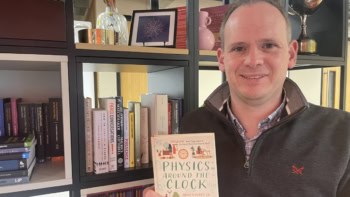
Courtesy: WPCA
By Hamish Johnston
…what do they have in common?
The answer can be found it the latest issue of Physical Review Letters.
In 1831* Michael Faraday published a paper in the Journal of the Royal Institute of Chemistry about what has come to be called “the wagon wheel effect”. The most familiar example is the illusion that a spoked wheel rotates in the wrong direction as a wagon moves across the screen in a motion picture.
This effect can usually described as a simple function of the angular frequency of the wheel and the frame rate of the film. However, under certain conditions the illusion defies this simple explanation — suggesting that part of the effect is related to how our nervous system and/or brain processes flickering images.
Writing in PRL three physiologists at McGill University argue that the flickering images picked up by the eyes amount to a periodic forcing of nonlinear neural oscillations. These oscillations occur naturally in the nervous system at frequencies of 1-100Hz, whereas a movie projector usually operates at 24 frames per second — so there might be something to it.
1831 was a busy year for Faraday. He also published a paper in the Philosophical Transactions of the Royal Society that introduced “Faraday heaps” to the world. When a tray of sand is shaken up and down, a number of small heaps are formed. These combine into larger heaps and eventually the tray contains jut one large heap.
While physicists understand why the single heap is the most stable configuration — a mathematical description of the merging process had remained elusive….until now.
Writing in the same issue of PRL and international team filmed the evolution of Faraday heaps in the lab and used these data to derive a set of differential equations that describe the process.
So that’s two 178 year old mysteries solved…
*According to PRL Faraday’s wagon wheel paper was published in 1831 — but according to the Royal Society of Chemistry website, this journal only began in 1841. Another mystery to ponder!



